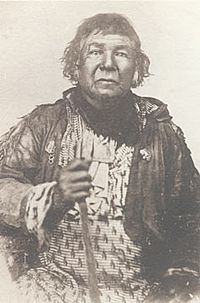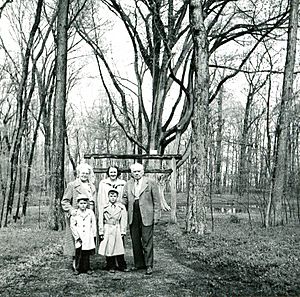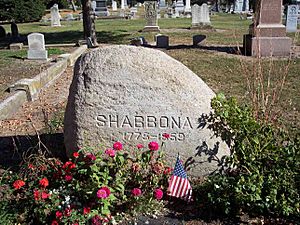Shabbona facts for kids
Quick facts for kids
Shabbona
|
|
|---|---|
 |
|
| Born | c. 1775 |
| Died | July 17, 1859 Section 20, Norman Township, Grundy County, Illinois, United States
|
| Resting place | Evergreen Cemetery, Morris, Illinois |
| Nationality | Ottawa, Potawatomi |
| Other names | Shabbonee |
| Occupation | Native American chief |
| Known for | Keeping Potawatomi people out of the Black Hawk War |
| Title | Chief |
Shabbona (born around 1775, died 1859) was a respected Native American chief. He was born into the Odawa tribe. Later, he became a leader among the Potawatomi people in Illinois. He lived during the 1800s and worked hard for peace.
Contents
Early Life of Chief Shabbona
Shabbona's name means "built strong like a bear." He was born around 1775. His family was part of the Odawa tribe. He might have been born in Ohio, Ontario, or Illinois. Some stories say he was born near the Kankakee River in Illinois.
The Odawa tribe spoke an Algonquian language. They moved west from Ontario to Michigan. There, they joined with the Ojibwe and Potawatomi tribes. Together, they formed the "Council of Three Fires." This alliance helped them move further south. Shabbona became very close to the Potawatomi people.
Shabbona was a grandnephew of Pontiac. Pontiac was a famous Odawa leader. Shabbona became a chief when he was quite young. His father was a warrior who fought with Pontiac. Shabbona himself became a trusted leader under Tecumseh. Tecumseh was a famous Shawnee chief. Shabbona fought with Tecumseh in the War of 1812. He was present when Tecumseh was killed.
Shabbona's Role in Wars
War of 1812
Shabbona was a skilled warrior. He fought with Tecumseh against the United States. This was during the War of 1812. Shabbona helped convince many Native Americans to join Tecumseh. They sided with the British against the American settlers.
After Tecumseh died, Shabbona changed his mind. He decided that fighting the United States was pointless. From then on, he became a friend and ally to the Americans.
In 1810, Tecumseh visited Shabbona's village. Shabbona agreed to help Tecumseh. He joined Tecumseh in recruiting other tribes. They visited the Potawatomi, Sac, Fox, and other tribes. In 1811, Shabbona fought at the Battle of Tippecanoe. After the battle, the tribes scattered. In 1812, Shabbona went to Canada. He joined the British during the war. After a British defeat, Shabbona returned home.
Red Bird Uprising
In 1825, a conflict called the Red Bird uprising happened. It involved the Winnebago tribe. Shabbona helped the Americans during this time. He went with other chiefs to find out if the Potawatomi were involved. He found the chiefs at a Winnebago village.
Shabbona bravely entered the village alone. He was held as a spy. The Winnebago agreed to release him. They made him promise to go straight home. They also sent an escort with him. Shabbona used this chance to send a message. He loudly complained about being held. This helped his friends, who were hiding nearby. They learned what happened and reported it. For his help, Shabbona received a land grant. This was at the Second Treaty of Prairie du Chien in 1829.
Black Hawk War
In 1832, Sauk Chief Black Hawk crossed the Mississippi River. This started the Black Hawk War. Shabbona met with Black Hawk. He warned Black Hawk not to fight the white settlers.
Shabbona knew he could not control all Potawatomi warriors. So, he rode across northern Illinois. He warned settlers about the danger. He warned William Davis and others. Sadly, some of these settlers were later killed. This happened at the Indian Creek massacre. During the war, Shabbona also guided the American militia.
Shabbona warned settlers many times. Once, he rode from Princeton to Chicago in one night. He did this to warn people of an attack. He was known for his efforts to keep peace.
Later Life
In September 1836, the Potawatomi were moved from northern Illinois. They traveled west in the rain. Shabbona and his group joined others. They went to Nebraska. Some stories say Shabbona returned to Illinois later. He is said to have spent his last days near Peru, Illinois. There is a place called Shabbona's Rock. He is remembered as a good friend to the white settlers. He always advised peace and cooperation.
Shabbona died on July 17, 1859. He was 84 years old. He passed away at his home in Grundy County, Illinois. In 1903, a large stone monument was placed on his grave. It is in Evergreen Cemetery. Shabbona's wife was named Coconako. She died in 1864. She is also buried near Morris, Illinois.
Shabbona's Legacy

Shabbona, Michigan
A community in Evergreen Township, Michigan, is named Shabbona. It was named in his honor before 1909.
Chief Shabbona Historical Trail
The Shabbona Trail was created in the 1950s. It follows paths Shabbona was known to have walked. The trail is 20 miles long. It goes from Joliet, Illinois, to Morris, Illinois. It is approved by the Boy Scouts of America. It features many woodland habitats.
The Fight for Shabbona's Grove
After Shabbona died, there was a long effort to reclaim his land. This land was a reserve of 1,280 acres. It was given to Shabbona and his people in the 1829 Second Treaty of Prairie du Chien. This land is now in DeKalb County, Illinois. The Prairie Band Potawatomi Nation has worked to get this land back.
For many years, the government did not recognize their claim. But in 2001, an official opinion said the land was indeed a reserve. It said ownership belonged to the Prairie Band Potawatomi Nation. The fight for this land continues today.
Images for kids


